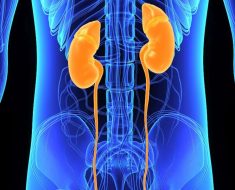Nonalcoholic fatty liver disease (NAFLD) is linked to an increased dementia risk, with an even greater risk in the setting of comorbid heart disease or history of stroke, new research shows.
Investigators analyzed data for almost 3000 older individuals diagnosed with NAFLD and compared them with a large group of matched peers without NAFLD.
At the end of the follow-up period of about 5 years, 5% of participants with NAFLD were diagnosed with dementia vs 4.6% of those without NAFLD. However, after adjusting for cardiovascular risk factors, those with NAFLD had a 38% higher rate of dementia overall and a 44% higher rate of vascular dementia.
“We found that NAFLD, a fat build-up in the liver, is associated with a higher risk of dementia, especially when the patient has both NAFLD and heart disease,” lead author Ying Shang, PhD, a postdoctoral researcher in the Department of Medicine, Karolinska Institutet, Sweden, told Medscape Medical News.
“The study calls for early cognitive tests in patients with NAFLD, especially for those with comorbid cardiovascular disease, and highlights the possibility that early and more targeted treatment of NAFLD and its cardiovascular comorbidity may reduce the risk of dementia,” Shang said.
The findings were published online July 13 in Neurology.
An Independent Risk Factor?
“NAFLD is regarded as the hepatic manifestation of metabolic syndrome, and metabolic disorders are shown to be well-known risk factors for dementia,” Shang noted.
Several other components of metabolic syndrome have been associated with a higher risk for dementia, but it is “unclear if NAFLD contributes to dementia independent of these factors,” she said.
In addition, attention and memory problems have been reported in patients with NAFLD, suggesting a link between NAFLD and poor cognition. However, previous studies examining this association have been “mostly limited to mild cognitive impairment with a cross-sectional design,” the investigators write.
“Given that 25% of adults have NAFLD worldwide, and given the aging population, it is important to understand whether NAFLD is associated with dementia independent of this metabolic disorder,” Shang said.
The researchers examined the Swedish National Patient Register for the years 1987-2016 and identified 2898 individuals with NAFLD (mean age, 70 years; 55.1% women). All were matched by age, sex, and city of residence at age of diagnosis with 28,357 individuals without the disease to act as the control group.
The patients and control group were followed for a median of 5.5 and 5.6 years, respectively.
Patients with NAFLD were more likely to have metabolic disorder, cardiovascular comorbidities, and depression compared with the matched control group (all Ps < .001).
Vascular Pathway?
During the follow-up period, 5% of the NAFLD group and 4.6% of the control group were diagnosed with dementia. The adjusted hazard ratio (aHR) was 1.86 (95% CI, 1.55-2.25) for the development of dementia in the NAFLD vs control group.
Although the association between NAFLD and dementia was attenuated after adjusting for metabolic disorders (aHR, 1.64; 95% CI, 1.29-2.07), and further reduced after adjusting for depression, stroke, and HD, it remained statistically significant (aHR, 1.3; 95% CI, 1.1-1.72).
Compared with the control group, those with NAFLD had higher rates of both dementia and vascular dementia but did not have higher rates of Alzheimer’s disease (AD). Having comorbid NAFLD and either heart disease (HD) or stroke “conferred a greater risk of dementia,” the researchers write.
|
Condition |
aHR (95% CI) |
|
NAFLD |
|
|
NAFLD and HD |
1.50 (1.08-2.05) |
|
NAFLD and stroke |
2.60 (1.95-3.47) |
|
NAFLD and AD |
1.15 (.78-1.70) |
The 5-year cumulative incidence of all-cause dementia was also higher for patients with NAFLD than for those without NAFLD (3.6% vs 2.05, respectively).
When the researchers compared the NAFLD group with members of the control group who had neither NAFLD, HD, nor stroke, they found higher rates of incident dementia in patients with any one of those diseases.
Having two disorders was associated with a twofold increased dementia risk (aHR, 2.00; 95% CI, 1.52-2.62). The “specific constellation” of comorbid NAFLD and stroke had the highest rate of dementia, the investigators note.
|
Condition |
aHR (95% CI) |
|
NAFLD |
1.42 (1.10-1.82) |
|
HD |
1.90 (1.43-2.53) |
|
Stroke |
2.12 (1.64-2.74) |
|
NAFLD and stroke |
3.04 (1.61-5.74) |
“This study provides Class II evidence that NAFLD is associated with incident vascular and non-vascular dementia,” the researchers write.
“We found that NAFLD is associated with dementia, especially vascular dementia. This association indicates NAFLD may affect cognition through vascular pathways,” Shang said.
In addition, a higher dementia risk was found in patients with both NAFLD and HD or stroke, “further suggesting the vascular pathway linking NAFLD and cognition,” she noted.
“The toxic metabolites produced in the injured liver may cross the blood-brain barrier, leading to neuroinflammation in the brain. So, taken together, our study suggests that NAFLD can both affect cognition directly and through cardiovascular disease,” Shang said.
Crucial Step
Commenting for Medscape Medical News, Jörn Schattenberg, MD, professor of medicine and director of the Metabolic Liver Research Program, Department of Medicine, University Medical Center, Mainz, Germany, noted that the finding showing the highest aHR, which was for vascular dementia, supports the hypothesis that NAFLD and, more likely, nonalcoholic steatohepatitis with hepatic inflammation, “affects extrahepatic outcomes — and liver inflammation is mechanistically involved.”
In addition, the strong effect size when HD was present “supports the concept of the incremental impact of risk factors on outcome,” said Schattenberg, who was not involved with the study.
Recognition of NAFLD “is increasing but still incomplete,” he noted. So it will be “important to identify NAFLD in primary and secondary care [and] inform the patient on the individual risk and empower them to implement self-informed change.”
Also commenting for Medscape Medical News, Galit Weinstein, PhD, senior researcher at the School of Public Health, University of Haifa, Israel, called the study “important” because it “adds another support for a possible link between NAFLD and brain health in older ages.”
The ability to treat dementia after it is diagnosed is “limited, therefore identifying treatable health conditions that precede its development is a crucial step toward dementia prevention,” said Weinstein, who was not involved with the study.
In its early stages, NAFLD can be treated through lifestyle change and medications, Weinstein noted.
No targeted funding for the study was reported. The investigators and Weinstein report no relevant financial relationships. Schattenberg has collaborated previously with the investigators in an analysis of the Swedish registry but was not involved with the current study. He also consults with companies developing treatment or diagnostic tests for NAFLD.
Neurology. Published online July 13, 2022. Abstract
Batya Swift Yasgur MA, LSW, is a freelance writer with a counseling practice in Teaneck, New Jersey. She is a regular contributor to numerous medical publications, including Medscape and WebMD, and is the author of several consumer-oriented health books as well as Behind the Burqa: Our Lives in Afghanistan and How We Escaped to Freedom (the memoir of two brave Afghan sisters who told her their story).
For more Medscape Neurology news, join us on Facebook and Twitter
Follow Medscape on Facebook, Twitter, Instagram, and YouTube
Source: Read Full Article





